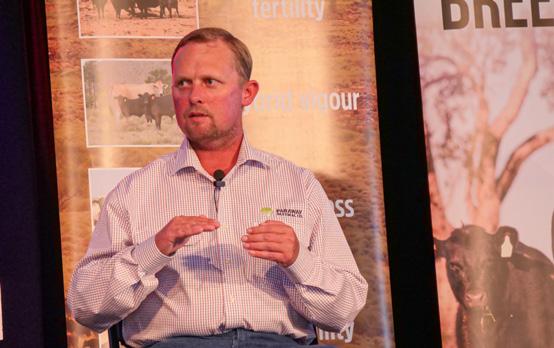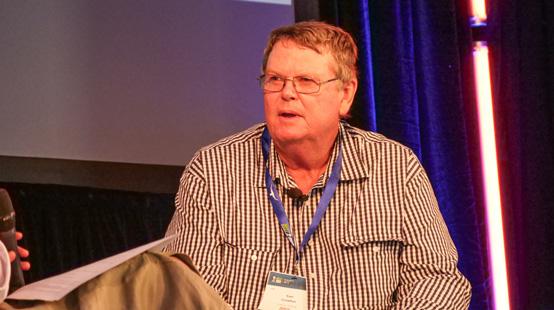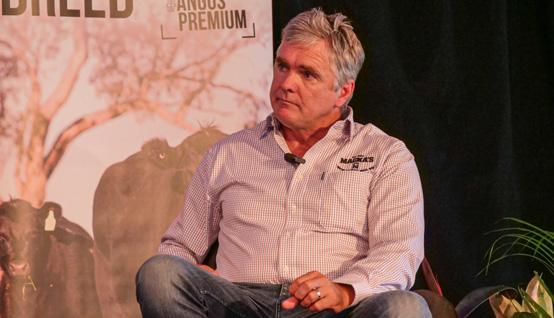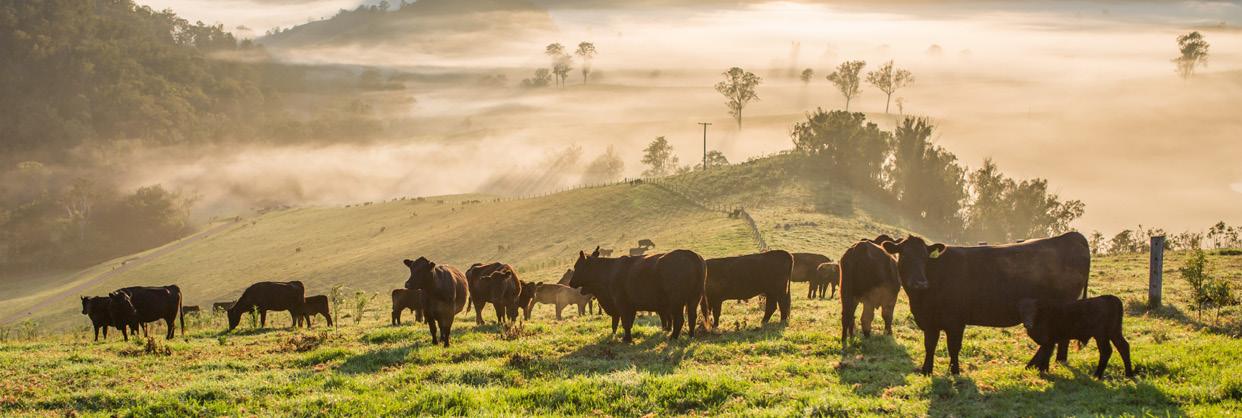
19 minute read
The Angus Influence – from Performance to profit
Cheyne Twist, Communications Officer
‘The Angus Influence – from Performance to Profit’ seminar featured as part of the Beef Australia 2021 program during May and showcased insights from a range of members of the beef industry, covering what makes businesses profitable and how producers have successfully utilised Angus genetics in their operations in northern and southern Australia.
Building a more profitable beef herd
Kicking off proceedings was Ian McLean, Director of Bush AgriBusiness, a professional service firm providing independent analysis and trusted insights to pastoral businesses across northern Australia. Ian is a co-author of the Australian Beef Report and lead deliverer of the Business EDGE workshop. and how many kilos of beef are produced from that. This is something the better performers consistently do, converting that grass into beef more efficiently giving them more income per animal unit.” Mr McLean also highlighted that with the top performers, there was bettered targeted herd expenditure. When looking at their discretionary herd expenditure, which covered things like supplementation, animal health, mustering and selling expenses, the businesses that perform better spend less than the rest per animal unit. Therefore, the discretionary money that these businesses are spending is better targeted in finding ways so they spend money to make money, while understanding that if they do not get the return on investment, they will not spend this money. Genetics were also identified as a highly important area of investment for beef businesses. Mr McLean highlighted that when it comes to genetics, it is an area in which money well spent can provide excellent payback for producers, whereas money not well spent does the opposite. “When selecting genetics, producers need to ensure that their management systems allow for the chosen genetics to fully express themselves, and to ensure that when selecting genetics, they must be those that will improve the bottom line for your production system”. “You are able to select on different things and don’t forget to focus on the bulls because bulls have more than 20 times the genetic influence that females do in terms of calves produced.” “There is an increasing amount of data, which Angus have been on the forefront of for a while, available on genetics, so use the indexes for selection. Identify the index most applicable to your production system as it’s a great way to rank bulls’”. It was also highlighted that the top performers use labour more efficiently in their businesses. This means having production systems and the infrastructure set up to do what needs to be done while doing it with less staff.
Separating the top performers
During his presentation Mr McLean highlighted what separates the top performers when it comes to producers in the beef industry, the economic impact of selecting for fertility and how to improve business and industry performance. When analyzing beef businesses, Agribusiness lines them up from top to bottom, looking at how they perform based on return on assets and therefore comparing the top performers to those at the bottom end of the spectrum and identifying differences. According to Mr McLean, whether it’s family businesses or larger businesses that rise to the surface, there is one thing they all do best. “They’ve got more productive herds, which means they’re more efficient at turning grass into beef.” “It’s not just the size of the animals, that’s important and part of the efficiency, but it’s the given amount of grass they’ve got to go into the system whether it’s measured in DSE (Dry Sheep Equivalent) or AE (Animal Equivalent)

Most importantly, Mr McLean identified greater operating scale as another key driver for top performances. “If you have operating efficiency and operating scale, you’ll have a good beef business. The abundance of one won’t make up for the lack of another.” In terms of metrics, Mr McLean identified herd productivity as the efficiency of production (North = kg beef/AE and South = kg/ha). The question posed to the audience by Mr McLean was “how efficient is your beef factory at turning grass into beef?”. He noted that there are a number of variables in efficiency of production including, reproductive rate, mortality rate and sale weight. These variables were established after research across a number of different data sets in northern and southern Australia of both small and large businesses. Some regional differences were established between northern and southern, based off data from the Australian Beef Report. What this research found was that in the southern areas of Australia, particularly the south east, the herds were found to be more productive based off more income per animal unit, due to the highly productive environment this data was pulled from, which results in generating more kilos of beef per animal unit comparatively to the more expansive, lower rainfall areas of the north. However, in terms of expenses per animal unit, of those with the highest income per animal unit, they also have the highest cost per animal unit, due to higher input systems and smaller operating scale compared to operations based in the north. “The south, as an average has lower profits then the north. That’s driven by scale because the average producer in southern Australia is a smaller scale than the average producer in northern Australia. Weight for weight, southern producers perform better in that the southern performer of scale will perform generally better than a northern producer of the same scale.” “What we shouldn’t interpret from this is that all of the south is less profitable. It’s just the south is more constrained by scale. What I think is more important than looking at the differences between regions is looking at the differences within regions. Every region has its challenges, advantages and disadvantages, both generally.” In terms of primary bottlenecks discovered during this research, herd productivity in the north is at a disadvantage, however operating scale in the south hinders profitability. Secondary to these considerations for both producers in the north and south to assist profitability is targeting herd expenditure and labour efficiency.
Fertility is key
Mr McLean discussed the QAAFI Project, a comprehensive study, drawing on the best available information on northern herd performance, business performance and genetics, undertaken to demonstrate the impact of genetic improvement of cow fertility on the bottom line of northern beef businesses. From this research, both fertility and growth improved profitability in the regions investigated, however fertility was found to have the greatest impact on the bottom line of each of the regions investigated. “The conclusions we came to from this study was that a balanced approach is best. Fertility should always be number one in selection for most production systems, and then in the more productive regions, the weighting on fertility can be turned down a bit and more emphasis given to other traits (eg carcase), however it still has to be at the top of the list. Know the profit drivers for your production system, your target market and your area and select for that.”
Planning is king
The key message for the audience was, “To always know what you are working towards in your businesses and improving business performance through identifying an end goal, current strengths and areas of improvement within said business”. Developing and implementing a plan for your beef business, and then adjusting that plan in review if necessary is imperative to ensure that producers are continuing to develop and be viable. And finally, remaining accountable for the decisions within your business is also incredibly important.

Beef Australia
Throughout investigations into large pastoral companies, Mr
McLean found one of big things that set those companies apart is the accountability that is inbuilt and how they are able to provide good quality information and remain accountable for their actions.
“Producers comparing their decisions and actions against their business plans ensures they are achieving what they have planned to and are remaining accountable regarding what needs to be done in order to ensure they are abiding by set goals”.
Seeking ‘grey heads’ or people knowledgeable in the industry is also an important avenue for invaluable advice or experience to assist in improving areas within businesses.
The Angus Influence
The second half of the seminar saw Angus Australia’s Northern Development Officer, Jen Peart sit down with Ben McGlynn, General Manager – Northern Region - of Paraway Pastoral Company, Sam Crowther, Harrow Grazing, Injune Qld and Robert McKenzie, Macka’s Pastoral, Gloucester NSW, to focus on producer experience with the utilisation of Angus genetics in both northern and southern beef operations.
Angus bulls on the barkley
Originating from the Riverina region in NSW, Mr McGlynn has spent his career working on and managing beef cattle properties in Northern Australia, most recently as the manager of ‘Rocklands’, Camooweal in Qld. Under his leadership, Paraway has been integrating the use of Angus bulls into their northern breeding operations, aiming to produce Angus Santa Gertrudis F1 progeny. Paraway’s Northern portfolio stretches over 4 million hectares running approximately 60,000 breeders, which are then transferred down into their growing operations further south. More specifically, Rocklands is a 1.8-million-acre breeding business that runs 32,000 joined females per annum. Within the wider operation there are two different breeding systems, being the original herd joined with Santa bulls, whose progeny are then joined to Angus bulls. The Angus progeny are then joined back to the Santa bulls. When asked about the breeding objectives and profit drivers for the company Mr McGlynn explained that Paraway remains key performance indicator driven. “The way we operate within the Paraway system is that each business is set up as its own enterprise and they operate their own profit and loss and we do internal transfers, which are actual sales. Basically, each business will have a different core KPI but overarching it is kilos produced per AE with our breeding businesses focusing on kilos produced per retained breeder. We do delve into weaning and branding percentages a little bit.” When it comes to their female herd, the operation fully segregates this. All females are preg tested annually and are put into two- or three-month calving groups, (Oct, Nov, Dec drop and Jan, Feb, March, April drop). Calving in October is a logistical decision based on environmental factors such as annual rainfall and flooding faced in the north. Females are mated according to their rate of puberty and their average daily gain (ADG) performance at joining, with age at joining anywhere from 15 months to 2 years, cutting them off at the December joining period around 280kg weight. 70% of calves are branded back onto their mothers in the first round and then the cows are weaned and preg tested in those aforementioned alternate groups as the they grow the kilos on progeny, in which the key driver in that is the body condition of the cow. Considering that bulls are run in rangeland areas of the Barkley, strict management practices are adhered to prior to and during the joining period to ensure performance. Angus bulls are purchased by the end of May and are on farm going into June, to ensure they are entering into a cooler climate to get them developed to the native rangelands prior to the joining period later in the year. As it warms up the bulls are fed supplements prior to a December joining. “That acclimatisation period is imperative for those six months in that particular environment.” Post joining the bulls are kept with the cows until preg testing then are pulled to be put on a supplement program. Typically, Paraway sees four seasons out of their Angus bulls, with those no longer productive culled with the unproductive females out of the herd. The primary drivers behind the utilisation of Angus genetics within Paraway’s cross breeding operation comes down to the ability to accommodate different traits. “Obviously IMF is important, and we could really hit our core KPI’s in terms of growth and what we’re going to deliver to our customers and to get that 60 per cent Bos Taurus influence basically fed us into the Angus Santa cross. That F1 progeny is working really well for us. It’s so highly profitable. And then in terms of sustainability for the progeny being joined back into the breeding herd sees some great results in heifer productivity.” Estimated Breeding Values (EBVs) play a crucial role in selection with some key metrics regarding where they select their Angus bulls from. They identify bulls from producers which are going to suit similar breeding environments including land type and nutritional values. “I think the first year was a bit of a learning experience and we have identified that we just needed to tighten that selection pressure up on those bulls, just in terms of coat scoring them because that’s very reflective through their progeny, I’m not a geneticist, but I’m sure it’s highly heritable. Then the complete structural soundness, as each bull is physically tested. The bulls are scrutinised to be able to operate in that in that environment.

And then focusing on the traits of carcase calving ease, mature cow weight, high fertility and good average growth.” When it comes to Angus genetics in the North, Mr McGlynn had a positive outlook on the utilisation going into the future. “In my experience, I was quite skeptical to see the performance of the Angus progeny in the north and how well or how much TLC the bulls would need. But it’s actually been a very positive result for our business in pretty trying circumstances, we’ve definitely put them to the test.”
Providing a cosistent and uniform product

Sam Crowther is principal of ‘Harrow Grazing’, a family beef cattle operation based in the Arcadia Valley in Central Queensland. The Crowther’s run a breeding enterprise across two properties, covering approximately 7,000 hectares and running 1,500 breeders. Within their operation, the Crowther’s join Angus and Santa Gertrudis cross cattle, and run a 650 head lot fed finishing enterprise, supplying both the short fed and domestic trade markets. Mr Crowther estimates that 90% of all turn off cattle are finished through their feedlot. The goal for their operation is to turn their cattle off quickly, with good weight, at a very young age consistently through their feedlot. They also do some forage cropping when available in order to support their cattle coming through the feedlot. “We like to keep our weaners going. We end up with some pretty sappy weaners when we go to wean about this time of year. The leads of our weaners are about 330 to 380kg and my goal is to keep those cattle going. We have a bit of oats crop we can put them on for a couple of months and then we induct into the feedlot.” The cattle are going into the feedlot about 460-480kg for a 100-day program for turning off to processors at the end of each year at approximately 16 months of age, averaging around 350kg carcase weight (cwt). “We have been able to do this because these cattle are good cattle. They’re really good, crossbred cattle, as the Angus and Santa really work together very well.” For a number of years, the Crowthers have also supplied cattle to Woolworths, with the cattle supplied turned off at approximately 270kg following a 70 day grainfed program. When it comes to their grain program, consistency is a key driver for the Crowther’s in order to maintain the good quality product to fulfill their contracts. “The biggest thing of feeding cattle grain is that they are getting that 12 or 13% protein and energy down their neck and if you give them that they will perform. If they don’t have that, you can’t meet those goals. So, my idea is to have those cattle going from when mum has given you a lovely sappy weaner to just keep him going and don’t let him have a setback.” “We’ve had too many dry years. This is one of the big reasons why we do it this way, because if you are getting a cash flow you are value adding a lot of benefits.” When asked why the Angus Santa cross works in their operation, Mr Crowther explained that it comes down to the suitability between the breeds. Mr Crowther highlighted that the breeds complement each other, “Joining with the Angus bulls, you end up creating a complete article, with fertility, calving ease, carcase, maturity patterns, weight gain and polledness”. “The greatest thing is that when you’re inducting cattle in the feedlot, you don’t have to use that drafting gate. You find that when you have that Angus content in them, they are just so uniform and consistent. They’re easy. They become easy for us.” “You certainly get the hybrid vigour with crossing Angus and Santa. When we send them to the abattoir I think they are at least 30kg heavier than a straight breed.” For the Crowther’s, utilising Angus genetics has delivered quick maturity and weight gain, and uniformity which is highly beneficial in the feedlot. When it comes to challenges to the Angus breed in his northern operation, Mr Crowther highlighted issues like ticks and heat tolerance are challenges they will always face, however parasite control and the utilisation of slight Bos Indicus content allows for management of these issues. When selecting Angus bulls, Mr Crowther highlights “confirmation and constitution’. “If you have their confirmation right, everything’s going to be right. There is nothing better than good constitution in cattle. If you can keep a beast in good order on minimum tucker it’s really valuable and it goes right through the whole chain. Then we look at the EBVs and the paper trails.” In terms of EBVs, Mr Crowther lists good growth traits, eye muscle, birth weight and calving ease as the key considerations. “We join all our maiden heifers to low-birth-weight Angus bulls, because we have a lot less problems. If you put the Angus bulls over them you get lots of calves, early calves.” When it comes to Angus influence on their profitability, Mr Crowther puts it down to production, meat quaility and money in the bank. “Angus are just good, if it’s dry you still have production and it’s keeping things moving. Every time you wake up in the morning you know you have a feedlot where the cattle are putting on 2-2.5kg a day.” Innovation keeps you at the forefront
Adding to the group was Robert Mackenzie, Founder and Owner of Mackas Pastoral and Mackas Australian Black Angus Beef. Mr Mackenzie is the fourth generation of family owned Mackas Pastoral, a commercial Angus beef operation based in the NSW Hunter Valley.
Beef Australia
Recently, the family has taken their beef to the world across 11 countries, exporting Mackas Australian Black Angus Beef, a Verified Black Angus Beef brand, with their key markets being China and the Middle East.
The Mackenzie’s breeding operations began in 1884, and in today’s age run their business over 8 properties in the
Hunter region, spanning 14,000 acres running 3,500
Angus breeders.
Their weaners are selected into two categories. The top group of steers, which are around 350kg at 8 months of age, are sold predominately through AuctionsPlus and the local sale yards. The remaining steers are put into their own backgrounding operations and then into a 150-day grain fed program for their branded beef operation. Innovation and technology have been key for the success at Macka’s
Pastoral and allowed them to tell their story to the world and
Mr McKenzie believes that producers need to continually adapt to the technology and programs available to them to stay at the forefront of beef production.
Mr Mackenzie launched Mackas Australia Black Angus Beef in 2016 for a number of reasons, however at the forefront was the fact that as a producer they found they were disconnected once they sold their cattle.
“Once we sold the cattle, we wanted to know, who was benefiting from that? Where are they going? Who’s getting the accolades for that hard work that we put in as a family operation?
We felt disconnected to where our product was going to, and we wanted to learn more. So that was a driving factor in that we wanted to connect with the end consumer.”
In terms of consumer perception, involvement in the Angus
Brand Verification Program with the Mackas Australian
Black Angus Beef brand, Mr Mackenzie believes that the verification gave their beef brand a marketing edge and a point of difference in terms of what the consumer wanted.
“The consumer wanted to know that it was Verified Black
Angus Beef, they wanted to know more about that and definitely on that world stage, those consumers want the best product. Food fraud is a massive issue. And I’m not saying that this solves a food fraud problem, but it actually gives that little bit more confidence to our resellers.”
Mackas Pastoral was also the first members to sell Angus
Verified steers as part of the newly launched Angus Verified program, achieving sale topping results. When speaking about the decision to be involved in Angus Verified, Mr
Mackenzie highlighted value adding as their reasoning.
“Angus Verified gives clarity to the breed, strengthens the breed, and it gave us a premium on that day. The buyer purchased those steers because they saw value knowing that they were pure bred. To feed animals in a feedlot is costly. In Australia, where we’re pricing ourselves out of the markets, so we have to do everything we possibly can to be sustainable and provide a high-quality and competitive product on the world stage and within Australia.” Mr Mackenzie believes that their success comes down to their female herd, and during times of environmental pressure highlighted the importance their female herd had in ensuring their high-quality product. With this maternal emphasis in mind, fertility, milk production and carcase traits were the main traits focused on by Macka’s when it comes to selecting bulls. “We’re far from being an expert at selecting bulls or an expert of breeding cattle, but we believe that we’ve had continuous growth, where we do try to expand and purchase property and we need to strengthen our female herd. Our objective this year is to hopefully have five thousand breeding cows.” “Our selection last year was predominantly focused on maternal traits, milk production and growth. And that will be our focus on the next couple of years because we don’t put any of our females in our boxed beef program. We usually retain about 30 per cent of our females, this year retaining more because of our potential growth.” When it comes to challenges in their area for Angus cattle, the Mackenzie’s have found that when bringing cattle to the coastal areas from inland there can be up to 6 months needed for the cattle to adapt to the coastal climate. Furthermore, ticks can be an issue. As a commercial producer, Mr Mackenzie highlighted programs such as Angus Verified as well as the ability to market Angus cattle and Angus beef as a driving factor for his continued utilisation of the Angus breed within the Mackas operation. “Marketing is key, people like to surround themselves with success and the marketing and support that Angus Australia provides its members is second to none. Programs like Angus Verified give commercial producers a chance to be part of Angus Australia and the support it provides.”












